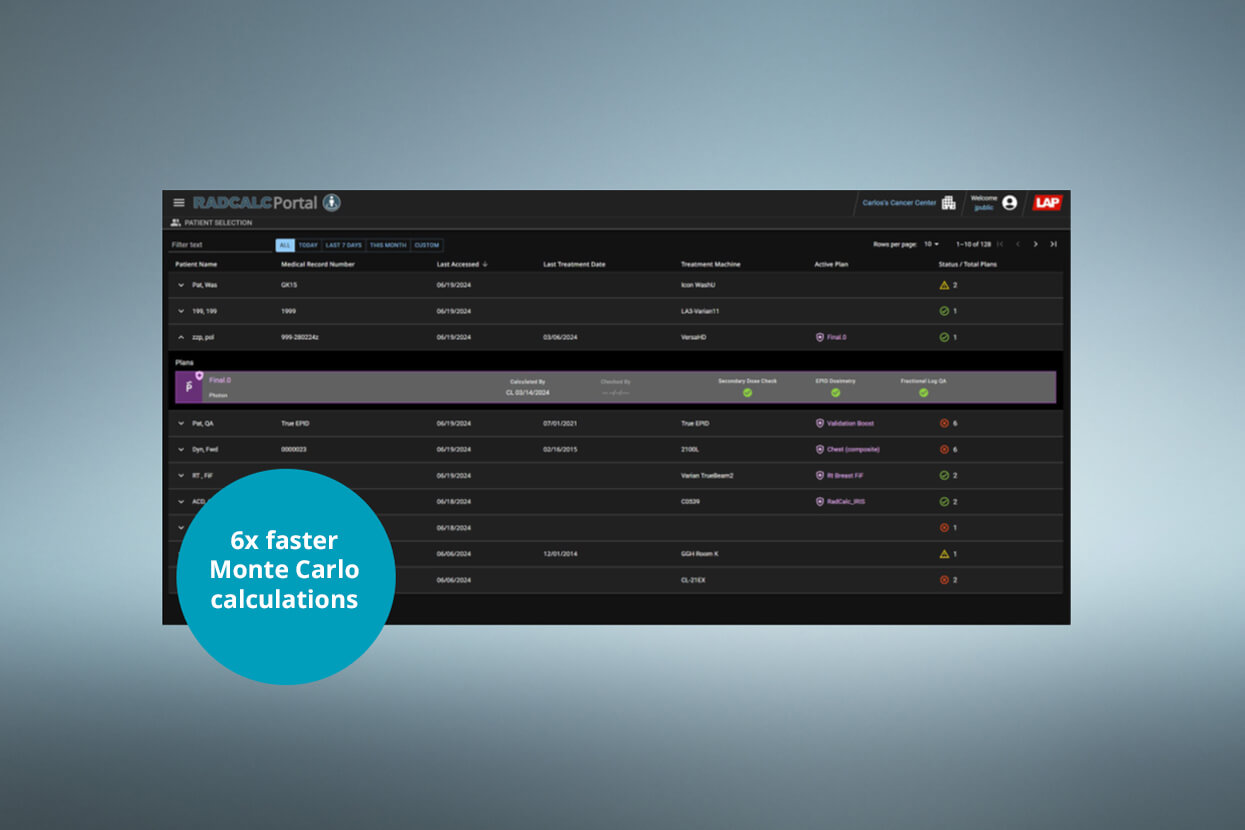Advancing Patient-Centric Quality Assurance with Fast Monte Carlo
We are pleased to announce key advancements in Monte Carlo-based 3D dose calculation methods integrated into RadCalc software for radiation therapy. Although not yet commercially available, these developments mark a significant step forward in enhancing the efficiency of patient-specific quality assurance.
Monte Carlo: The Standard for Accuracy
Monte Carlo dosimetry simulations remain the most accurate method for modelling complex photon and electron interactions within varying patient anatomy. However, users desire faster computational times for clinical use. The new Fast Monte Carlo algorithm in RadCalc addresses this challenge, reducing computation times significantly while maintaining a high standard of accuracy.
Innovative Speed Gains through GPU Computing
RadCalc now performs Monte Carlo dose calculations up to six times faster than traditional methods, improving the speed of quality assurance workflows [1,3]. These advancements utilize GPU-based parallel processing and pre-calculated electron tracks to expedite dose calculations, enabling medical physicists and dosimetrists to verify even complex treatment plans rapidly. This speed advantage also supports online adaptive radiotherapy workflows where changes are made to the daily treatment plan. Near real-time patient-specific QA is crucial when patients are waiting on the treatment couch.
Optimized Workflow with Pre-calculated Monte Carlo (PMC)
Using Pre-calculated Monte Carlo (PMC) methods in RadCalc allows for the efficient reuse of precomputed electron track data, optimizing dose calculations within patient geometries. This ensures a streamlined workflow and reduces calculation times without sacrificing the precision required for complex radiation treatments.
Enhancing Patient-Centric Safety
These advancements are designed to improve both patient safety and treatment personalization. RadCalc’s accurate calculations ensure that each personalized treatment plan optimized to the patient’s specific anatomy has its QA performed directly on that patient's specific anatomy and not on a surrogate homogenous phantom, reducing uncertainty in treatment delivery. Truly understanding the clinical impact of dose variations enables clinicians to deliver safer, more effective radiotherapy with greater confidence.
Additionally, the significant reduction in computation time enables more efficient validation of complex plans, such as those used in SBRT and IMRT, ensuring treatments are delivered on time and within stringent safety margins.
Rigorous Validation and Testing
The Fast Monte Carlo enhancements in RadCalc are currently going through a range of rigorous validations, from simple water phantom studies to complex heterogeneous geometries such as lung SBRT plans. When benchmarked against other Monte Carlo systems, such as BEAMnrc, RadCalc demonstrated equivalent accuracy while significantly reducing computation time. This ensures that RadCalc is well-prepared to meet the increasing demands for precision in complex radiotherapy plan verification.
References
1. Heng, V. J., Renaud, M. A., Seuntjens, J. (2024) 'GPU-based Monte Carlo dose calculation using precalculated electron tracks', AAPM 2024
2. Jia, X. et al. (2011) 'GPU-based fast Monte Carlo simulation for radiotherapy dose calculation', *Physics in Medicine and Biology*. Available at: https://arxiv.org/abs/1107.3355 [Accessed: 9 September 2024].
3. Siantar, C. L., et al. (2001) 'Description and dosimetric verification of the PEREGRINE Monte Carlo dose calculation system for photon beams incident on a water phantom', *Medical Physics*, 28, pp. 1322–1337.
4. Kawrakow, I. (2000) 'Accurate condensed history Monte Carlo simulation of electron transport, I. EGSnrc, the new EGS4 version', *Medical Physics*, 27, pp. 485-498.

